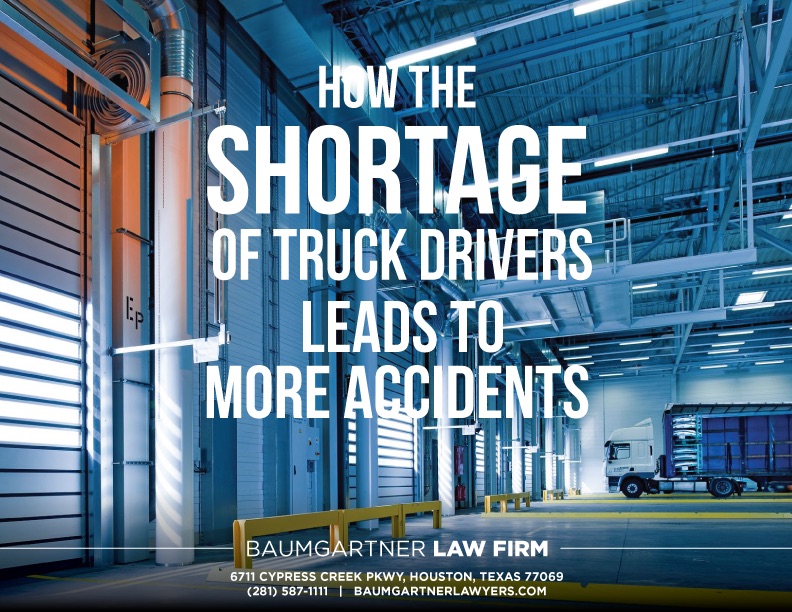
 Request FREE consultation - 1866-758-4529
Request FREE consultation - 1866-758-4529 

Shortages of drivers cause more truck wrecks, and the solution is complex.
There is no doubt that the trucking industry is the lifeblood of our American economy. The proof is in the pudding, with over 70% of all freight transported throughout the United States arriving on big rigs. Tractor-trailers haul more than 10.5 billion tons of goods and freight each year.
The United States has over 11 million big rigs registered, representing a 3% increase from the prior year. Approximately half of all commercial truck drivers transport freight interstate, and around 15% transport freight intrastate.
According to the Federal Motor Carrier Safety Administration, commercial truck drivers were cited over 320,000 times for violations related to duty status during roadside inspections. Fudging the duty status or failing to keep accurate logs is one of the most common safety violations by truck drivers. Additionally, the FMCSA indicates that there were over 136,000 hours of service violations, where truck drivers drove despite being prohibited from doing so by safety regulations.
While the shortage of truck drivers has been consistent at approximately 30,000 drivers over the last several years, industry analysts suspect that the driver shortage will reach between 50,000 and 100,000 drivers per year. There are several reasons for the driver shortage, one of which is the age of the existing drivers, who are typically around 50, and younger drivers not finding the profession as attractive.
Turnover has been a significant problem for the motor carrier, as drivers find other vocations that may offer a better work-life balance, allowing them more time with their families. Trucking companies have struggled to find enough qualified drivers and are often forced to accept drivers who may not be as professional and safe as the motor carrier would prefer. All one has to do is turn on the radio to hear numerous ads from trucking companies seeking drivers, which helps illustrate the depth of the truck driver shortage.
Retiring truck drivers who are not easily replaced is probably the single largest factor in the shortage of drivers.
Many motor carriers are offering substantial incentives for the best truck drivers. Some of the larger trucking companies in America have increased pay by $ 5,000-$10,000 a year for their top drivers. The competition for highly qualified and safe drivers has never been fiercer.
Last year, over 475,000 large trucks and buses were involved in accidents. There is a direct correlation between the experience of a truck driver and the potential for a serious truck wreck. It is common sense that the more experience a driver has behind the wheel of a tractor-trailer, the less likely they are to be unprepared on the roadway.
The number of injury crashes from big rigs has increased substantially in recent years, according to the Federal Motor Carrier Safety Administration.
Inexperienced drivers and new drivers are clearly the most dangerous truckers on the highways. Many truck drivers quit the profession after they have been in a very serious truck accident where someone else was seriously injured or killed. Controlling an 80,000-pound vehicle requires more than a commercial driver’s license and minimum safety training by a company.
Solutions to the Driver Shortage
There has certainly been a sustained increase in freight shipped in the United States, along with a growing need for qualified truck drivers. One of the biggest problems, besides the age of the drivers, is the inability to attract younger drivers to stay in the profession.
Trucking companies are offering financial incentives. However, the increased pay and sign-on bonuses are insufficient to deal with the magnitude of the driver shortage. Increased flexibility and home time are significant factors in driver job satisfaction. There is no doubt that trucking can be a difficult lifestyle for families.
Technology advances will help trucking companies become more flexible with their drivers as long as the companies are willing to invest resources into the technology. Recent rule changes requiring electronic logging are a step in the right direction for motor carriers to adopt technology, reduce costs, and improve safety.
Better communications are also proven to reduce aggravation for drivers and improve on-time delivery.
Summary
In the United States, we face a serious truck driver shortage, which forces motor carriers to hire less qualified drivers to fill positions. The shortage of qualified drivers is expected to increase substantially in the near future. Trucking companies are taking steps to attract higher-quality drivers; however, the industry’s primary challenge remains a shortage of drivers.
A correlation exists between the age, experience, and training of the truck driver and the likelihood of an accident. A new driver is much more likely to be involved in an unnecessary crash than an experienced driver.
Call (281) 893-0760 for a free injury accident consultation.
Visit our Conroe truck accident page
Related Resources: